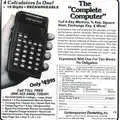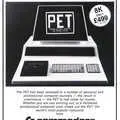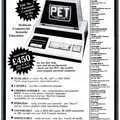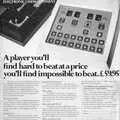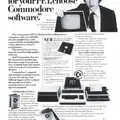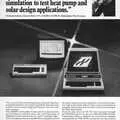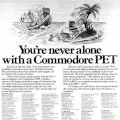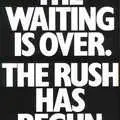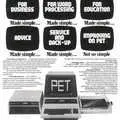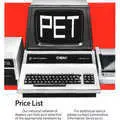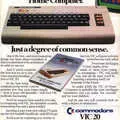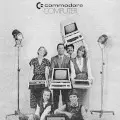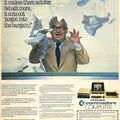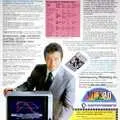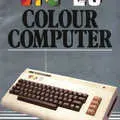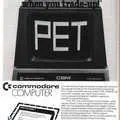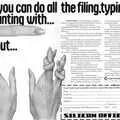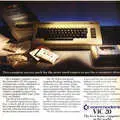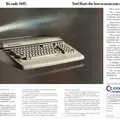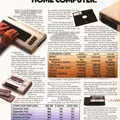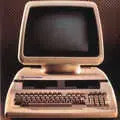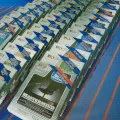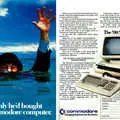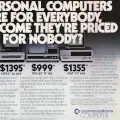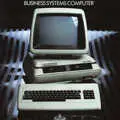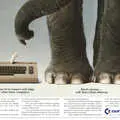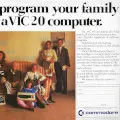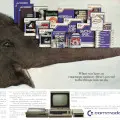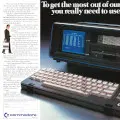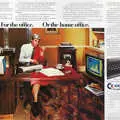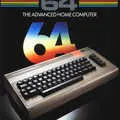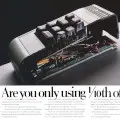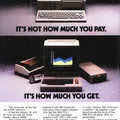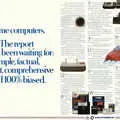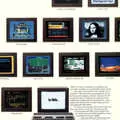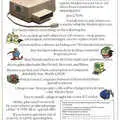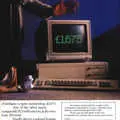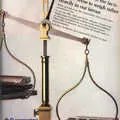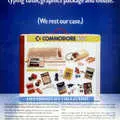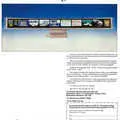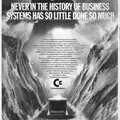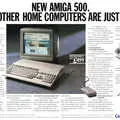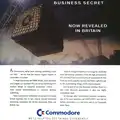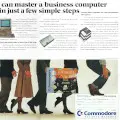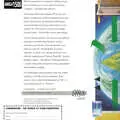
Commodore Advert - June 1986
From Sunday Times

Commodore 64: The World's Best-Selling Computer Now Comes ... With a Mouse
The first trackball pointing device had been invented way back in 1941 by Ralph Benjamin as part of British Royal Navy project[1], but the computer mouse is generally credited to Douglas Engelbart and Bill English at Stanford.
Theirs had been invented in 1963 but was not shown until the "Mother of all demos[2]" in 1968.
However, a few weeks before Engelbart showed off the prototype mouse in his famous demonstration, German company Telefunken had started shipping what is the closer template of nearly all modern computer mice, at least up until the invention of optical versions, with its ball-based mouse. Engelbart's was based on two wheels which worked only on X and Y planes.
In 1983, Microsoft entered the hardware business for the first time when it produced its own £140 (£610 in 2025) mouse[3] and by 1984 mice were finally becoming mainstream, popularised initially by their use in the Apple Macintosh and later by the Commodore Amiga and Atari ST.
By the end of 1989, Datel's Art Studio for the 64 was available complete with software, Commodore's 1351 mouse, mouse mat and holder, for only £30 (£100).
Commodore, in turn, released the 64C as an updated mouse-equipped version of its original Commodore 64.
The C64, released in 1982, was becoming the machine that wouldn't die, even though Commodore had tried to shut down production more than once during 1985[4].
Each time it did, user demand meant that production had to be started up again. Even though there were better micros around, the C64 was by now cheap and had a huge software catalogue available for it.
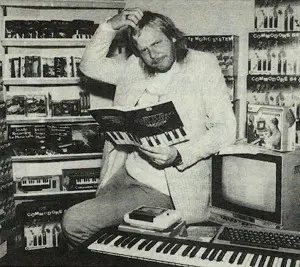
Rick Wakeman promoting the Commodore 64 music system at the 7th Commodore Computer Show, held at the Novotel in May 1986. © Commodore User, May 1986A re-design for the 64 had first been suggested at the Personal Computer World Show in September 1985.
That idea was put on ice whilst Commodore put more effort into promoting the existing 64 as part of a musical application suite, with plug-in synthesizer-style keyboards, Rick Wakeman and the like.
The C64's SID sound chip was still considered by some to be unsurpassed for the price[5].
However, Amstrad's purchase of Sinclair in April '86 had been seen to give Amstrad an instant near-monopoly on the home-entertainment micro market in the UK.
This was a situation which Commodore's Chris Kaday openly acknowledged was the trigger for the re-launching of the 64 and the tweaking of the 128's market positioning.
This included a new printer bundle which Kaday denied was intended to take on Amstrad's PCW[6].
The re-launched and re-designed "C" version of the C64 was built with the more-modern low-slung and beige case as used in the Commodore 128, and was launched at 1986's Summer CES in June.
Its eventual appearance was a close-run thing as the company was admitting that the machine wasn't quite the same crowd-puller that it had in its new Amiga.
It had considered not launching at CES at all and had even been trying to off-load its hotel suite just before the show, before deciding that an absence might have generated the wrong sort of headlines[7].
When it did appear at CES, its new GEOS window-and-icon disk operating system, produced by Berkeley Softworks of California[8], proved to be one of the more interesting parts of the show, with Commodore claiming that GEOS was the first mass-market mouse-driven system available anywhere for less than $250.
It would become, at least for a while, the third-most popular operating system after MS-DOS and Mac OS[9].
The 64C was expected to arrive in the UK during August, with the first 64Cs being available in shops before September's Personal Computer World show.
The will-they-won't-they show shenanigans were repeated before the Personal Computer World show as well, with the uncertainty becoming something of a Commodore tradition.
Commodore's PR company was at first unsure, then certain that the company was not going to the show, before deciding that it was, although Commodore itself seemed convinced all along that it was going.
Even so, its stand was thought to be a modest affair - again concentrating on its Amiga and PC compatibles - whilst rival Atari was expected to "blitz" the show and perhaps overshadow Commodore with its much larger presence[10].
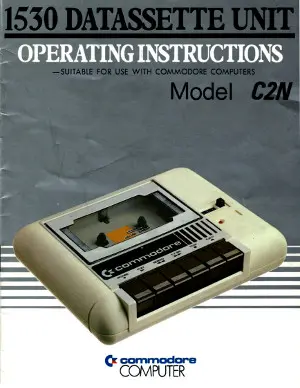
Commodore's C2N Datasette, later modelThe box set on offer in the advert (which calls the mouse "a sophisticated little device") also includes a "datasette".
This was Commodore's term for its dedicated cassette player/recorder unit which, whilst relatively slow, was considered as much more reliable than regular tape recorders.
It was also initially expensive - retailing as an optional peripheral for £45 in early 1982, or about £210 in 2025 money - but was eventually bundled "free", as the C2N, with every Commodore machine sold.
Conventional domestic tape cassette players that were used with most other home computers of the time used regular audio encoding - which could be easily overwhelmed if levels were too high - whilst the C2N used digital encoding and verification.
Writing in response to a reader's letter enquiring about whether it was worth adapting a normal cassette player in order to save money, Personal Computer News's Max Phillips wrote "First and foremost you should keep in mind the reliability of Commodore's dedicated unit"[11].
Protek did eventually release a custom cassette interface for Commodore computers which retailed for £10 and which allowed most standard cassette players to be used, in a move that was partly in response to a shortage of Datasette units during the Christmas period of 1983[12].
One thing that did upset Datasettes, especially well-used ones, was the increase in use of "turbo loaders" during the mid 1980s. These circumvented Commodore's 300 Baud load-twice process in favour of much higher Baud rates and no error correction.
This meant that the sorts of problems that affected hi-fi audio tapes - loss of high frequencies over time, Wow and Flutter - all played a much more significant part.
Even a badly-vibrating drive belt or a flat spot in the pinch roller could prevent a turbo-loaded program from loading properly.
Remedies included replacing the tape head, removing the belt that drives the tape counter or even removing the plastic case, which sometimes warped the metal chassis of the tape mechanism[13].
An ultimate solution was to move everything on to disk, but even that was becomming awkward thanks to improving anti-piracy measures.

Commodore's Corby factory and UK HQ, partly closed in February 1986. © Commodore Horizons, March 1986Unusually for a Commodore advert, there's no price displayed anywhere, which was odd as Commodore would usually bang on about how its machines were always cheaper than the competition.
That's because, as an old-computers.com article[14] points out, this version was about $80 more expensive than the standard C64.
This minor fact was more significant than it seems as it marked the first time ever that the price of the C64 had gone up instead of down. To Compute! magazine at least, in an article published in February 1987's issue, it marked the official end of the various microcomputer price wars[15] that had raged since Commodore started the first in 1983, primarily to exact revenge on Texas Instruments in return for the Calculator Wars of the mid 1970s.
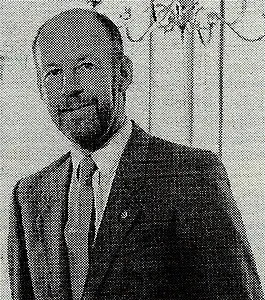
Chris Kaday, Commodore's acting general manager - promoted after only six months at the company, © Popular Computing Weekly, May 1986Back in early 1986, a couple of reports - from AGB and IDC - had placed Commodore at second-place with around 20% of the UK market, behind Sinclair at around 37%.
There was some confusion over exactly who was second behind Sinclair, with an alternative reports from Wood Mackenzie suggesting that Commodore was fourth.
Some of the confusion was perhaps explained by the fact the both Commodore and Acorn were stock-dumping at the time, with Commodore flogging off large quantities of unwanted Plus/4s and C16s and Acorn shedding 150,000 Electrons in Dixons' direction[16].
Second place or not, from the start of 1986 Commodore was facing increasingly tough times with the first rumours of possible bankruptcy starting to float around.
The company had accrued losses of $113 million (about £300 million in 2025) for the financial year ending June 1985, which continued through to the end of that year with a $53.2 million loss over Christmas, and it was forced to restructure its factories in early 1986, closing Corby in the UK as well as a California chip plant.
The announcement of the Corby closure immediately cast doubt on the C16 and the Plus/4, which were assembled solely in Corby, although sales and marketing director Chris Kaday was suggesting that
"The C16 and Plus/4 have recently been very successful, although rather late in their lifetime. We will be assessing the demand for these products and I do not see why we cannot continue production if the demand is still there".
Meanwhile, general manager Nick Bessey was expressing some sadness over the loss of jobs, saying
"Naturally we regret the impact of this decision on workers who will lose their jobs, but we have been forced to recognise that difficult decisions must be taken in the agressively competitive marketplace that exists[17]".
By the February of 1986, Commodore was having to actively deny suggestions that it would file for bankruptcy protection under the US's Chapter 11, suggesting that it was "totally out of the question - there is no truth in the speculation whatsoever", despite several US financial analysts casting doubt on the company's ability to survive.
President of analysts Future Computing, Egil Juliussen, had said:
"If the bank calls in the deadline, then [Commodore] have no choice but to file for Chapter 11. Although the US rules are reasonable, the problem is one of perception with customers and dealers. Even if they do file, they still have plenty of time to reorganise. It would be a big blow, but not the end of the world"[18].
At least Commodore had had a good Christmas, selling over 1.1 million computers worldwide, which meant it could pay back a reasonable wodge of cash to its bankers, which in turn agreed to extend its other repayment deadlines through to the end of February[19].
Juliussen was also predicting that Commodore could sell 20,000 Amigas per month in the US, with an average price of about $2,000 per system giving it around $500 million in revenue for the year. He continued "But will they have enough time? It all depends on the banks".
The situation wasn't helped too much by an announcement by company CEO Marshall Smith, which, according to Guy Kewney, effectively said that Commodore was not "going bankrupt - we have another month", followed by a statement that there would be a further announcement from Commodore's bankers on the 12th March 1986[20].
In that follow-up announcement, it was revealed that Commodore had agreed further extensions to its credit facilities, which were now up to $135 million (about £350 million in 2025), which gave it 13 months in which to restore its profitability.
Somewhat amusingly, this had apparently been spun in a Commodore press release to read as Commodore having a "strong credit line"[21].
Enigmatic chairman of Commodore International Limited, Irving Gould, said of the move that:
"we have been working closely with our banking partners. In a series of recent meetings, we reviewed our forward plans including our product strategies and comprehensive cost-reduction programme already in progress"[22].
The losses continued to mount through 1986, however, when Commodore reported a further loss - its biggest yet - of £24.7 million on sales of £121.5 million worldwide, for the first quarter of the year.
More than half of its revenue was coming from Europe, with Gould suggesting that the performance of the US branch of the company had been "disappointing".
However, there were some signs that the Amiga - the machine the company was essentially banking on to pull it out of its financial crisis - was starting to shift units, with Commodore UK's Chris Kaday reporting that the first week's UK shipment of 1,000 Amigas had already sold out[23].
Although the company initially planned to lease back part of the Corby factory in order to house the remaining 160 sales, admin and servicing staff, by June 1986 it was looking likely that the company would move out completely, having shed another 70 jobs as it closed down its sales and servicing team, leaving only 60 staff at in Corby's "echoing caverns"[24].
Commodore UK's Chris Kaday, who had been with Commodore for only six months and was now the acting general manager since the departure of Nick Bessey, pointed out that "It is a very large facility, about 210,000 square feet. There are only so many such sites in the UK, and only so many looking for this sort of place. We have not got very far yet"[25].
Meanwhile, Thomas Rattigan, president of Commodore International Limited, stated that "Commodore would be concentrating on fewer plants using higher technology", which essentially meant Commodore's Braunschweig plant in Germany in terms of European output.
Closing Corby - the last Commodore British manufacturing base - with the loss of 250 jobs, also meant that Commodore had to repay grants given to it by the UK Government some 18 months before in order to encourage the building in the first place[26].
Negotiations over repayments had actually started with the Department of Trade and Industry (DTI) back in January.
Commodore had been given a £2 million grant to encourage it to move to the region - on account of Corby's status as a steel-closure town - as well as a £197,000 development grant and a further £2 million loan from the European Steel and Coal Federation, which had to be paid back in full.
The exact terms of the original grants were not public, but it was known that if the company transferred any of the equipment bought with the development fund, or ceased to use the plant for its original purpose, then there would be grounds for repayment.
It was also revelealed that Commodore had invested a total of £80 million in Corby (£300 million in 2025) of which £20 million was spent setting up the assembly line[27].
None of this stopped the partisan Commodore Computing International magazine from spinning the press reports of Commodore's dramatic fall in public favour in to a positive, by suggesting (despite the losses) that Commodore made more profit per employee than any other micro company, including IBM, with £56.58 per employee versus IBM's fifth-placed £18.56[28].
That was presumably "profit" before all those other pesky accounting deductions, like interest, taxation, depreciation and, er, losses.
As part of its slimming down, Commodore also offloaded its spares distribution service to HRS Electronics of Birmingham. Chris Kaday said
"We have now transferred spares and warehousing to third parties - National Carriers are running the warehousing for instance. However, the equipment is all still on Commodore's concrete, here in Corby, so to speak. You see, we're not disappearing down the tubes, we're just scaling things down"[29].
The grim news all came at a time when Commodore was due to finally launch its long-awaited Amiga at the Commodore Computer show between May 9th and 11th at the Novotel in Hammersmith[30] - the machine that everyone was raving about and which Commodore hoped would rescue it.
Meanwhile, there were some alternative suggestions as to why Corby had failed, including why everywhere else apart from the UK had been shipping the improved version of the 64 only two weeks after it was announced, and why only Commodore UK seemed incapable of ensuring appropriate stock levels of anything, which was apparently why only 1,000 Amigas had been shipped in the machine's first month, despite the demand.
Guy Kewney, writing in Personal Computer World, seemed unsurprised that Corby had been "taken away from British management", and reported that a recently-departed senior Commodore executive had said that the closure of Corby was "a suitable follow up to the UK company's triumph in losing more dealers than Apricot and launching the Amiga at something like 40% above what international management recommended"[31].
Kaday was featured again after the eventual launch of the Amiga 500 into the UK market in the March of 1987, when he was was reported as saying that the C64 "still has a role" and that it was "still selling well, believe it or not".
That was despite the fact that the C64 was now over four years old and the A500 was being targetted not only at the 64's same first-time user segment but was also being sold as an upgrade away from 8-bit machines entirely.
However, Kaday was quick to point out that "people will buy [the 64] because of its software base, and it still has a role as a fun computer", so much so that the company was in talks with various High-Street retailers to help finalise the details of its latest bundle, which was being designed to replace the Connoisseur's Collection bundle of this advert[32].
Even by 1989 - a full seven years after its launch - the ageing 8-bit 64 was still trundling on in the face of a swathe of 16- and 32-bit upstarts.
It was the dawn of the CD-ROM era with software house MirrorSoft having recently released its "Defender of the Crown" on CD, so one attempt to keep the 64 relevant was Rainbow Arts' "1st CD Edition".
This didn't actually give true CD-ROM capability to the 64 but instead used the audio output of a regular CD player via a cassette-port converter to load software.
As a result, it was no faster than a turbo-loader on a regular cassette-based game, plus it required an actual CD player, which at the time cost something like £150 (about £500 in 2025) and which was no doubt spending every available minute playing Dire Straits' Brothers in Arms - the first CD to sell a million[33].
Your Commodore concluded of this attempt that:
"although Rainbow Arts has been quite brave in testing the water with this package, it has cut corners as far as paying for new games and the production standards of the interface are concerned. If you don't have a CD player then forget it. If you already do, and you can lug it close enough to your computer then all you have to worry about is whether you really want the benefit of having ten very old games and some forgettable music on a compact disc. This isn't the technology of tomorrow, this is Rainbow Arts trying to cash in on a current fashion"[34].
---
Back in 1985 the 64 scored something of a first when the appropriately-named First Software released an Ada compiler for the machine.
Ada, named after Ada Lovelace, assistant to Charles Babbage, was said to have been the first computer programmer when she wrote an algorithm for Babbage's Analytical Engine in 1852[35]. Ada the language, on the other hand, was the favourite of the US Department of Defence where it was "the number one choice for controlling missile systems"[36]
Date created: 17 May 2013
Last updated: 11 December 2024
Hint: use left and right cursor keys to navigate between adverts.
Sources
Text and otherwise-uncredited photos © nosher.net 2025. Dollar/GBP conversions, where used, assume $1.50 to £1. "Now" prices are calculated dynamically using average RPI per year.
